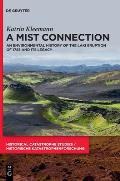Teleconnections of 1783
As the eastern U.S. of A. deals with smoke from forest fires in Canada, it seems appropriate to link to a recorded book talk about a similarly widespread environmental phenomenon that started in 1783.
I’ve mentioned Katrin Kleemann’s research a couple of times before. In this recording, she describes her book A Mist Connection: An Environmental History of the Laki Eruption of 1783 and Its Legacy, published this year, and answers questions.
The video description says:
For example, the eruption of 1783 didn’t kill thousands of Icelanders in an explosion; rather, it poisoned the air and the pasturage, killing most of the crops and livestock, and that led to widespread famine. The event has also been linked to a famine in Egypt as decreased rainfall in Africa put less water in the Nile. Some historians argue the volcano was also a factor in the French famine of 1785, which exacerbated the Revolution that started four years later.
I’ve mentioned Katrin Kleemann’s research a couple of times before. In this recording, she describes her book A Mist Connection: An Environmental History of the Laki Eruption of 1783 and Its Legacy, published this year, and answers questions.
The video description says:
In the summer of 1783, an unusual dry fog descended upon large parts of the northern hemisphere. The fog brought with it bloodred sunsets, a foul sulfuric odor, and a host of other peculiar weather events. Inspired by the Enlightenment, many naturalists attempted to find reasonable explanations for these occurrences.One of the concepts Kleemann uses in this talk is “teleconnections,” a term borrowed from meteorology to refer to the effects of a weather phenomenon distant in space and time from that event. An event can also have teleconnections within societies, she argues.
Between 8 June 1783 and 7 February 1784, a 27-kilometer-long fissure volcano erupted in the Icelandic highlands. It produced the largest volume of lava released by any volcanic eruption on planet Earth in the last millennium. In Iceland, the eruption led to the death of one-fifth of the population. The jetstream carried its volcanic gases further afield to Europe and beyond, where they settled as a fog, the origin of which puzzled naturalists and laypersons.
A Mist Connection is an environmental history that documents the Laki eruption and its consequences for Iceland and the wider world. The book combines methods of historical disaster research, climate history, global history, history of science, and geology in an interdisciplinary approach. Icelandic flood lava eruptions of this scale have a statistical recurrence period of 200 to 500 years; it is crucial to understand their nature so that we can prepare for the next one.
For example, the eruption of 1783 didn’t kill thousands of Icelanders in an explosion; rather, it poisoned the air and the pasturage, killing most of the crops and livestock, and that led to widespread famine. The event has also been linked to a famine in Egypt as decreased rainfall in Africa put less water in the Nile. Some historians argue the volcano was also a factor in the French famine of 1785, which exacerbated the Revolution that started four years later.


No comments:
Post a Comment